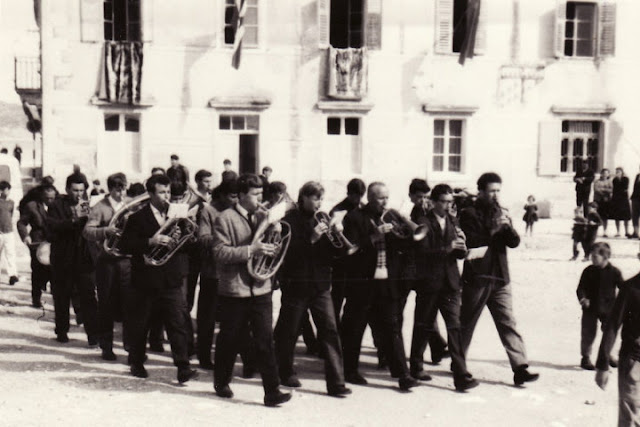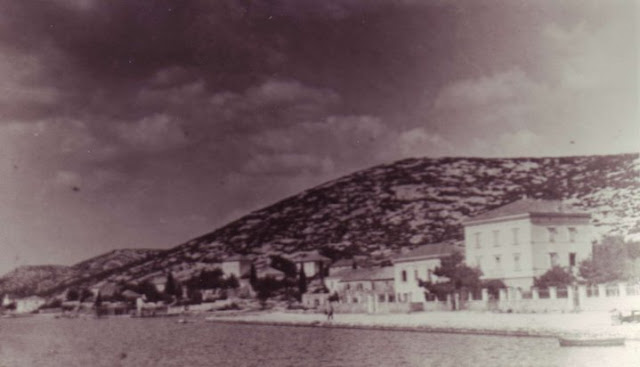Christmas. What a wonderful time of the year! Up until this year most of my Christmas celebrations have been more or less the same - Christmas Eve is spent with my father's family, Christmas Day with my mother's and Christmas evening out on the town with my cousins. Christmas in Australia is always associated with summer holidays, basking in the sun and jumping into the ocean. But I anticipated this Christmas to be somewhat different. And it surely was...

A few days before Christmas my neighbour Teo and I went to pick-up my grandmother from Sibenik bus station. She had been in Belgrade with my aunt for a sorrowful occasion (and my aunt was to join us in Tisno a week or so later). Upon arriving, she looked extremely exhausted and disheveled. Teo and I were both very keen to get her home. I had prepared dinner for us earlier that day, but Teo and his wife insisted that we dine with them that evening (no Tišnjanin would ever allow you to refuse an invitation to dinner, or lunch, or any other occasion involving food).
The following day, I was expecting my grandmother to take it easy - she'd just spent over 12 hours in a cramped bus, which isn't too much fun when you're 24, let alone 76. I've done the Tisno-Belgrade and Belgrade-Tisno bus trip one too many times, visiting family there and although the buses are reasonably comfortable, the trip is overwhelmingly monotonous (freeways aren't the most exciting of routes to take - although the new highways have shortened the trip considerably, they have also made is considerable more boring - it was much more interesting when you had to go through all the small towns on the way), especially when you complete it on your own. Being in her old kitchen, my Baba (grandmother) set about making
sarma for our lunch.
Sarma is made from pickled cabbage leaves, stuffed with a mixture of minced beef, port, ham and rice. This rissole-like mixture is wrapped in individual cabbage leaves. These 'parcels' are then placed into a pot with extra sauerkraut and smoked port ribs which is then covered in a thin tomato-based 'soup' and put to simmer for an hour or so. It is usually served with mashed potatoes or
kaša (cooked polenta). Leftover
kaša is fantastic served with warm milk the following morning for breakfast - it's a Dalmatian thing. As usual, she cooked enough sarma to feed an army, so we planned to eat is for the following few days. Although this plan was disregarded after our 'Christmas gift' the following day.

I had planned to have dinner with Darko and some friends, and my grandmother had decided to have dinner with her 'adoptive' family (my grandmother grew up in a hamlet in the Dalmatian hinterland. She was orphan during the Second World War, sent to a Red Cross orphanage in Alexandria, Egypt and then placed in Tisno as a servant girl in the then wealthy Kaleb household, but basically became an extra member of their family). My grandmother had already left for the evening and I was just stepping out of the front gate in the evening darkness when I perceive my neighbour Teo bounding up the street (Teo is always bounding - he has this insatiable energy and happiness about him) with a large parcel in his hands. As he comes towards me, he asks me to go ahead of him and open the front door. I do so and let him in. He walks into our kitchen and plonks the parcel onto the table. He slowly unravels the butcher's paper to reveal a whole turkey - all cleaned and plucked and ready to prepare. He on goes to tell me that he was at his ranch (his little 'farm' just outside of Tisno which houses his menagerie of turkeys, chickens, rabbits and pigeons, as well as a selection of various fruits and vegetables - I remember going there one year to pick sour cherries) that day and brought us back a turkey for Christmas dinner. I told him we'd already made plans to go out that evening and I didn't know what the two of us would do with an entire turkey, so I told him to take it back for his own family. Refusing to listen to my answer, he left and went on his merry way. The following day my grandma even attempted to give it back to him, but we ended up eating this turkey for the following week. And were rather creative with it - we boiled parts for soup, we poached it, we prepared a fantastic roast on Christmas day, we made turkey sandwiches...although the turkey was the most amazing I had ever tasted, lets just say I didn't touch turkey for a while after that.

Christmas Eve dinner at Darko's was roasted octopus! The Dalmatian adore their seafood, but unfortunately most stores do not sell quality goods, even though we are right on the coast. The fish market in Tisno typically has a depressingly poor selection of fish, unless you're eager enough to be there are 6am as the fishing boats pull in and manage to strike a bargain with the skipper. But for the regular Tišnjanin, finding decent fish is usually the result of a few precise telephone calls. A number of men in town are known for their fishing talent, so you call a number of them and ask if they've caught the thing that you're particularly after, in this case octopus, in the last few days. If they say no, you continue on to the next person on the phone list, and when you finally obtain a positive response, you offer them a price for the octopus in kuna (the official Croatian currency), through a favour - painting a room in their house, helping with some tiling, etc, or through a barter exchange for wine, spirits, beer, olive oil, vegetables, etc.
After our delicious dinner and dessert of
fritule (little round deep-fried doughnut-like delicacies, about the size of a golf ball, made from a light and fluffy batter with raisins and sprinkled with icing sugar), we and almost the entire town attended midnight mass at the Church of the Holy Spirit. The church was literally overflowing with Tišnjani - all the seats were taken with people standing at the rear of the church, in the doorway and also outside. Unlike the weeks prior, and the weeks following Christmas and New Year, Tisno was teaming with people, as many Tišnjani living in other parts of Croatia and Europe return home for the holidays. After mass everyone wished each other a Merry Christmas in the courtyard of the church building. As all the 'oldies' went home to their warm beds, the youth packed into Kaseopeja (the tiny, two room caffe-bar in Uska Ulica) and the younger teenagers into their second home, Crni's Caffe Bar (located at the opposite end of the town centre). Being freezing cold outside, about fifty of us squeezed into Kaseopeja and somehow managed to close the doors shut - you could barely take a step without bumping into someone, that's how packed it was. The evening continued until dawn with people signing well-know Croatian rock songs from the 80s and 90s, somehow attempting to dance in any small opening between the crowd they could find, as well as general drunken, but reasonably orderly behaviour from a number of the boys, and a few of the girls too. It was better than any summer party, as it consisted only of true Tišnjani, and Tišnjani know how to party. (I'll refrain from post photos, saving many people a great deal of embarrassment).

Christmas day was a quiet affair, with the majority of Tisno nursing a hangover. Although many, as was to be expected, continued the festivities in Kaseopeja the following night, despite this.









































